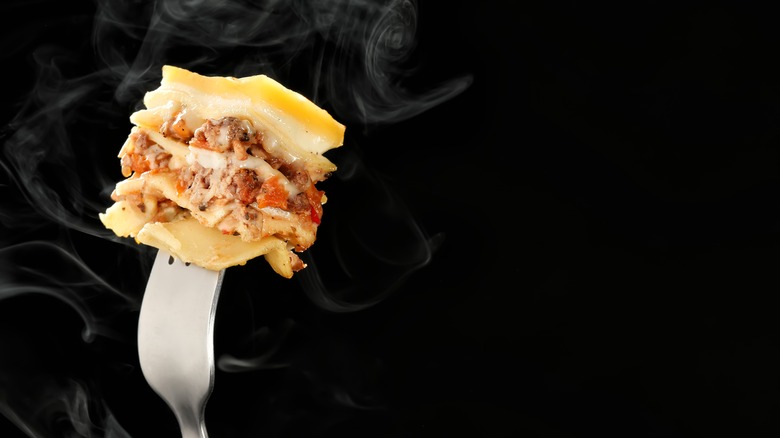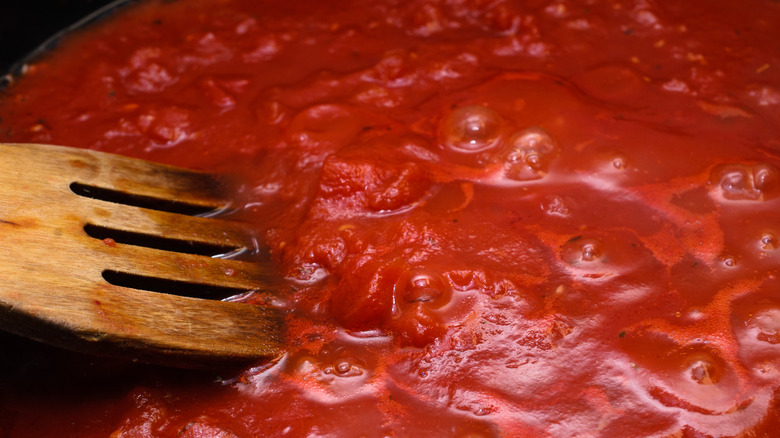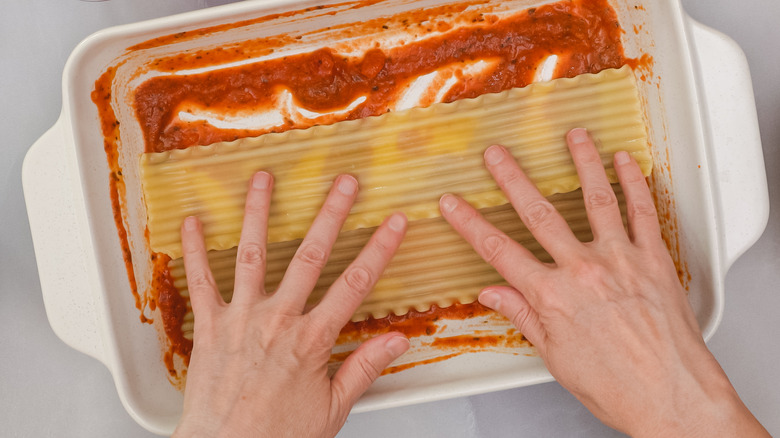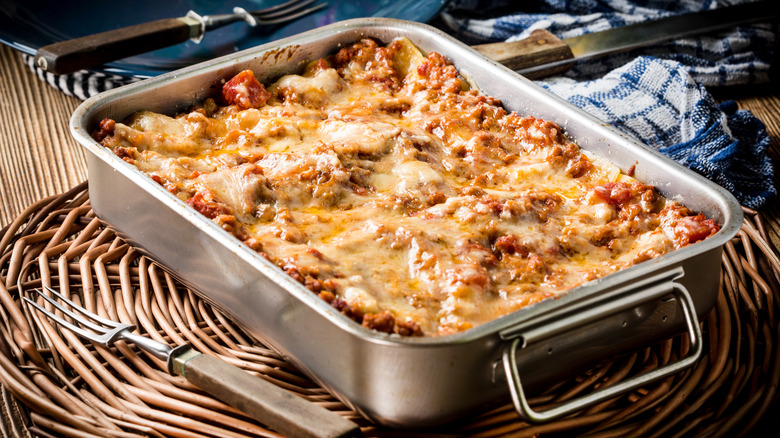Lasagna Napoletana Is The Ultra-Decadent Dish You Need To Know About
Cheesy, meaty, hearty, and warm, lasagna ticks all the boxes as far as comfort foods go. An official Garfield-approved dish, the success of lasagna can be attributed to its many layers, each carefully crafted with just the right balance of savory ingredients. A time-consuming feat, the beloved Italian staple is a serious labor of love, especially when it comes to a jazzed-up version like lasagna napoletana.
Throughout Italy, there are countless renditions of the pasta dish. You might already be familiar with the northern Italian version, lasagna bolognese, however, if you venture to southern Italy, the recipe changes almost completely. While the concept of layered pasta remains very much the same, the ingredients and traditions surrounding lasagna vary. A fully-loaded version, lasagna napoletana conjures up images of Nonna in the kitchen, simmering sauce and shaping meatballs. With more ingredients than you could imagine, this ultra-decadent lasagna will have you craving seconds, and maybe even thirds.
A brief history
Synonymous with Italian identity, Sapere Sapori explains that the origins of lasagna trace back to ancient Roman gastronome Apicius, who first wrote of a baked dish called lagane that consisted of pasta layered with meat. While there is some dispute over which came first, the bolognese or the napoletana, Visit Naples shares that it wasn't until centuries later that the dish morphed into what we know it as today, attracting the attention of poets, authors, and even royalty like King Ferdinand II (dubbed "King Lasagna") who's credited with popularizing the Neapolitan version.
Regardless of when exactly it came to be, lasagna napoletana plays an integral role in Neapolitan tradition, especially during carnevale. A chance to indulge before observing the restrictions of Lent, Campania Tradizione explains that carnevale is a celebration best commemorated with an abundant lunch. Unsurprisingly, a feast of gluttony requires decadent dishes, which is where the rib-sticking lasagna napoletana comes in.
The rich ingredients involved
A good lasagna is layered with flavor — flavor that can only come from a surplus of rich ingredients. According to La Cucina Italiana, lasagna napoletana consists of pasta sheets layered with a braised pork and sausage tomato sauce, sliced salami, tiny homemade meatballs, sliced hard boiled eggs, and a variety of cheeses like ricotta, fior di latte mozzarella, provola, and pecorino. As for those meatballs made in-house, they're prepared by mixing ground pork with breadcrumbs or soaked, stale bread, eggs, salt, pepper, parsley, and a grated hard cheese like pecorino or Parmigiano-Reggiano, notes TasteAtlas.
Naturally, like any traditional recipe, there can be variations on the iconically decadent lasagna napoletana. The sauce and addition of meatballs remains to be untouched, but Recipes from Italy notes that some families might choose to omit pieces of salami or hard-boiled eggs, whereas others might opt to add different local cheeses to the dish.
How to make Neapolitan-style lasagna
Given that making lasagna napoletana can be quite lengthy, it's wise to start the sauce the day before. A slow simmer of onions, garlic, basil, chunks of pork and sausages, a splash of wine, and crushed, whole tomatoes allows incredible flavor to develop, reports Serious Eats. But, that's not the only thing that must be done in advance. Before assembling the lasagna, Italy Magazine explains that the mini meatballs must be shaped and fried, in addition to slicing, chopping, and grating the other ingredients — even the pasta might need to parboiled if you aren't using fresh sheets.
Once everything is prepped, the layering process can begin. Great Italian Chefs recommends spreading sauce on the base before adding the first layer of pasta, which then can be topped with ricotta, cubed cheese, meatballs, salami, eggs, and sauce. Although you could also alternate between meat and cheese layers, there should be a total of about five layers, before adding a final bit of sauce and cheese and baking for roughly 30 minutes.
How to serve lasagna napoletana
Although it can be tempting to dig in right away ... don't! Take a tip from the wise (read: any Italian Nonna) and make sure to let that lasagna rest — this will not only prevent you from burning your mouth, but it'll ensure clean slices of the cheesy pasta dish.
Of course, what's a slice of lasagna without a glass of wine? A bottle of savory and beautifully acidic Sangiovese can compliment almost any lasagna style, but Wine Folly recommends pairing lasagna napoletana with a full-bodied, spicy red that also comes from southern Italy, called Aglianico.
Though it's unlikely that you'll have leftovers, Giallo Zafferano confirms that lasagna will keep for about 2 days when kept in a sealed container (or in the pan covered with plastic wrap) and refrigerated. Given that the lasagna is prepared in stages, you can even assemble it a day in advance and store it in the fridge overnight.
Lasagna napolitana vs. lasagna bolognese
Although they are both equally decadent in their own regard, there are a few key differences between lasagna napoletana and lasagna bolognese. First and foremost, lasagna napoletana hails from the southern Italian region of Campania, unlike the bolognese that has roots in the northern region of Emilia-Romagna. That said, the main differentiating factor is actually based on the ingredients used.
According to La Cucina Italiana, the Campanian version features a hearty pork-infused ragù and layers of softer cheeses like ricotta and mozzarella, in comparison to the Emilian rendition that boasts levels of minced meat ragù and creamy bechamel sauce. The Neapolitan version also adds a bunch of extras like eggs, salami, and meatballs that are atypical of a lasagna bolognese. Il Cucchiaio D'Argento even states that lasagna bolognese uses egg pasta whereas traditional lasagna napoletana tends to use egg-free sheets made from durum wheat semolina.





